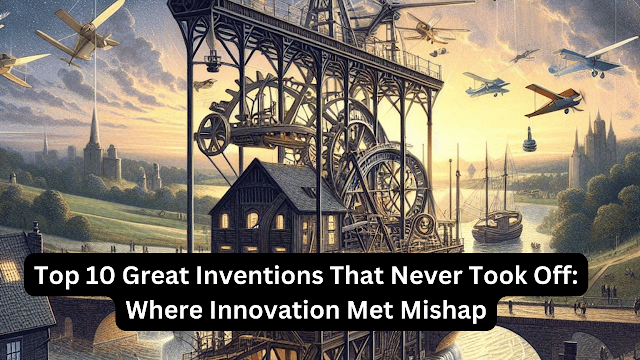Top 10 Great Inventions That Never Took Off: Where Innovation Met Mishap
Not every brilliant idea takes off. Explore the Top 10 Great Inventions That Never Took Off,
from futuristic gadgets to practical solutions that just missed the mark.
Discover their stories and ponder the fascinating "what ifs" of
scientific progress.
Introduction:
The human spirit is brimming with innovation, constantly pushing the boundaries of what's possible. But not every invention, no matter how ingenious, finds its place in the world. Some stumble upon timing issues, others face technological limitations, and some simply fall victim to the fickle winds of consumer preference. Today, we delve into the fascinating realm of " Top 10 Great Inventions That Never Took Off," uncovering stories of brilliance and missed opportunities.

Top 10 Great Inventions That Never Took Off
Top 10 Great
Inventions That Never Took Off:
1. The Electric
Pen (1875): Edison's Electrifying Flop
Imagine a pen that could instantly create copies –
Thomas Edison's electric pen promised just that. However, its clunky design and
messy operation relegated it to a footnote in history, paving the way for more
refined copying technologies.
2. The Ford
Nucleon (1958): Atomic Ambition, Radioactive Reality
The Nucleon, a concept car powered by a nuclear
reactor, showcased Ford's futuristic vision. But safety concerns and the
impracticality of a miniature reactor grounded this dream car before it ever
hit the road.
3. The Betamax
(1975): VHS Stole the Show
Betamax boasted superior picture quality, but its
hefty price tag and limited recording time paled in comparison to the more
affordable and flexible VHS format. This seemingly small difference in
convenience ultimately sealed Betamax's fate.
4. The Segway
(2001): A Two-Wheeled Balancing Act That Lost Its Balance
The Segway promised effortless personal
transportation. However, its high cost, limited range, and safety concerns
prevented widespread adoption, relegating it to a niche market.
5. Google Glass
(2013): A Glimpse into the Future, But Not Everyone Wanted to See
Google Glass aimed to revolutionize wearable
technology. However, privacy concerns, limited functionality, and a hefty price
tag left consumers divided, and the project eventually fizzled out.
6. The Newton
(1993): Apple's Pen-Based Gamble
Apple's Newton, a personal digital assistant with
handwriting recognition, was ahead of its time. But its clunky design and
unreliable handwriting recognition hampered its success, demonstrating the
challenges of pushing technological boundaries too quickly.
7. The DeLorean
Time Machine (1981): Back to the Future, But Not at the Box Office
The DeLorean DMC-12, with its gull-wing doors and
sleek stainless-steel design, became iconic thanks to the "Back to the
Future" movies. However, its underpowered engine and high price tag
limited its appeal in the real world.
8. The HD-DVD
(2006): Blu-ray Took the High-Def Crown
The HD-DVD format offered superior picture quality to
DVDs. However, a fractured industry, incompatible formats, and the rise of
Blu-ray ultimately tipped the scales in favor of its competitor.
9. The LaserDisc
(1978): A High-Tech VCR That Couldn't Compete
LaserDisc offered superior picture and sound quality
compared to VHS. But its high cost, bulky format, and limited content library
hampered its success, ultimately losing the videotape format war.
10. The Newton
MessagePad (1993): A Palm-Sized PDA Ahead of Its Time
The Apple MessagePad, a precursor to the iPhone,
offered email, calendar, and note-taking capabilities in a compact form.
However, its high price, clunky interface, and limited battery life limited its
appeal.
Conclusion:
These " Top
10 Great Inventions That Never Took Off " serve as a reminder that
innovation is not a guaranteed path to success. Timing, market factors, and
even seemingly minor details can play a crucial role in determining an
invention's fate. Despite their short-lived existence, these ideas offer
valuable insights into the ever-evolving landscape of technology and inspire us
to continue pushing boundaries while learning from the past.
Recommendations:
- Research the historical context and market conditions surrounding each invention to understand the factors that contributed to their failure.
- Analyze the strengths and weaknesses of each invention to identify what could have been improved.
- Consider how these inventions could be reimagined or adapted for success in today's market.
FAQs:
Q: Can these
inventions ever make a comeback?
A: Sometimes! With technological advancements,
changing market conditions, or effective rebranding, some forgotten inventions
have found new life. For example, the Segway is now used in specific niche
applications like security patrols and guided tours.
Q: What lessons
can we learn from these failed inventions?
A: These stories remind us that innovation is not a
guarantee of success. They highlight the importance of considering market
needs, timing, and usability. They also emphasize the continuous cycle of
learning and adaptation in the world of invention.
Q: Are there any
success stories of inventions that were initially rejected?
A: Absolutely! Many inventions faced initial
skepticism before achieving widespread success. Examples include the microwave,
the telephone, and even the personal computer. Persistence, refinement, and
adapting to market needs can turn rejection into triumph.
Q: Where can I
learn more about these fascinating inventions?
A: Many resources offer deeper dives into these
stories. Online articles, documentaries, and books dedicated to innovation
history can provide further insights and details. Museums and historical
exhibits sometimes showcase these technologies as well.
